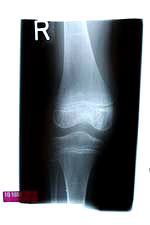Bones, Joints & Muscles

Knee Pain
 Knee Pain is thought to affect 1 in 3 teenagers at some time or other.
Knee Pain is thought to affect 1 in 3 teenagers at some time or other.
A Physiotherapist assessing and treating a child’s knee needs to be mindful that the pain could be referred from the hip. If this is suspected an x-ray is required, with referral to an Orthopaedic Consultant if indicated. There are specific conditions that affect children’s knees. These are quite different to the problems that adults tend to develop.
Osgood-Schlatter Disease is an inflammation of the bone, cartilage, and/or tendon at the top of the shinbone (tibia) where the tendon from the kneecap (patella) attaches. It is not truly a disease and is one of the most common causes of knee pain in adolescents.
Typical features include:
- OSD is more common in active boys aged 10 – 15 years.
- Mostly only one knee is affected
- Pain that worsens with exercise
- Limping after exercise
- Pain that is relieved with rest
- Swelling or tenderness below the knee on the bony lump called the tibial tuberosity
- Tightness and weakness of the muscles surrounding the knee (the hamstring and quadriceps muscles)
Patellofemoral Pain Syndrome (PFPS) was previously known as Chondromalacia Patella. PFPS is a complex condition where the knee cap (patella) tracks slightly offline causing the under surface to grate along the femur (thighbone). Typical Features include:
- PFPS is most common in active teenage girls
- Commonly associated with flat feet and / or knock knees
- Pain is experienced in the inner knee area
- Symptoms are aggravated by activity (running, jumping, climbing or descending stairs)
- Or during prolonged sitting with knees in a bent position (this is called the "cinema sign")
- A sense of "tightness" or "fullness" in the knee area
- The feeling that the leg may give way
- Weakness in the muscles around the hip and knee
- Mild swelling of the knee area
- Grating or grinding sensation when the knee is straightened
Other conditions causing knee pain in children include:
- Hip conditions e.g. slipped upper femoral epiphysis (SUFE) and perthes
- Meniscal problems – tears are rare in children but discoid menisci may cause symptoms
- Sinding – Larson and Johansson disease
- Arthritis
KidsPhysio will assess the cause of the knee pain.
- Testing the muscles to see if they are weak or tight
- Looking at your child’s posture and walking pattern to see if it is contributing to the pain, for example if your child has flat feet or knock knees
- Carry out special tests for ligaments, menisci and patella mal-tracking
Treatment may include:
- Application of Kinesio tape or rigid tape to help settle inflammation, address alignment issues or help activate weak muscles
- Advice on exercises to be carried out at home
- Advice on pain management
- Advice on sports and activities
- Advice on footwear/insoles/orthotics
- Electrotherapy (ultrasound etc) is rarely indicated and often contra-indicated in children’s conditions